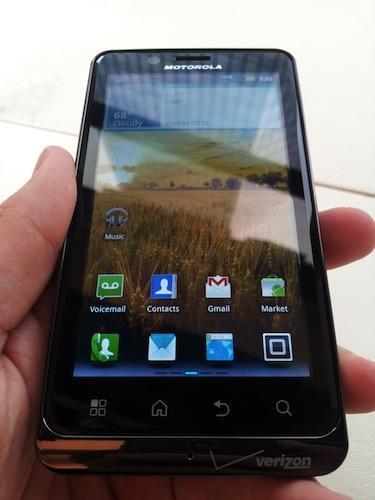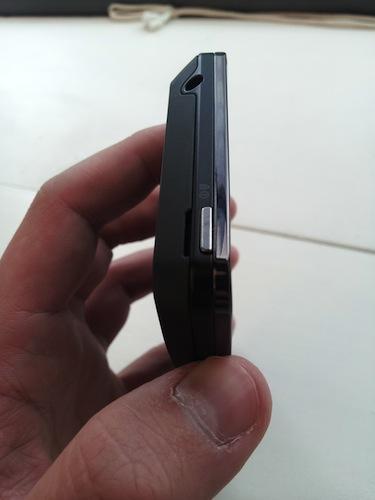
Until recently, Android fans seeking a true high-end device on Verizon Wireless have been presented with a challenge. On one hand, the carrier has a few dual-core 3G devices, but if you wanted the power of 4G LTE with a zippy processor, you were out of luck.
After nine months of delays, the Motorola DROID BIONIC is finally here. It's dramatically different from the version we saw at CES, but the internals are mostly similar - 1 GHz dual-core CPU, 4.3-inch qHD display, 8-megapixel camera with 1080p HD video capabilities, and Android 2.3. It's packed to the gills with up-to-date features, but it'll be going up against a bevy of hot devices this fall: the US-bound Galaxy S II variants, Apple iPhone 5, rumored DROID Prime, and the HTC Vigor, just to name a few. Fashionably late to the party and priced at a lofty $249.99, can the DROID BIONIC "rule all machines," as Verizon's advertising campaign suggests?
If the Motorola DROID X2 and DROID 3 got together and had a baby, the BIONIC would be the result. Measuring in at 5-inches long by 2.63-inches wide by .43-inch thick, the front closely resembles the curves of the DROID 3, but offers the telltale DROID X2-like camera hump. On the left spine, you'll find the microUSB charging port and HDMI port, while the right spine contains the volume rocker. The 3.5mm headphone jack and power button are located on the top.

In the box, you'll get an AC adapter module, USB cable, 16 GB microSD card (installed in the phone), and instruction manuals. BIONIC has a 4.3-inch qHD display, and like many of the recently launched high-end Motorola handsets, it's utilizing PenTile technology. On one hand, PenTile is best when it comes to power consumption and makes for a much brighter screen due to an added pixel, but it's known for pixelation in comparison to the other high-resolution technologies on the market. It'll boil down to personal preference, so be sure to compare qHD to other high-resolution display technologies before committing to it for a full contract term.
If you're looking for a fast Android phone, the combination of 4G and dual-core processing power will appeal to you. The 1 GHz dual-core processor performs well, handling multiple running apps and other system-intensive processes with ease. BIONIC packs Android 2.3.4 (Gingerbread) with Motorola's custom user interface. Though they've mostly standardized the UI across the new Motorola devices, there are some minor differences. For example, the BIONIC's menu scrolls from left to right instead of up and down (PHOTON); it only has five homescreens instead of seven (Atrix 4G); and it's missing the white hue around the dock area. Overall, Motorola's new UI is a huge improvement over MOTOBLUR and the Applications Platform found on the DROID X and PRO. The blue color scheme is a nice change, and it's not nearly as obtrusive as past versions.

With an 8-megapixel camera, the BIONIC performs decently in the image department, though pictures are still somewhat grainy. Editing options include effects (normal, black and white, sepia, negative, solarize, red tint, green tint, blue tint), scenes (auto, portrait, landscape, sport, night portrait, sunset, macro, steady shot), modes for single versus multi-shots, brightness, and more. The camera shoots 1080p HD video, and while the audio was a bit blown out, the image quality was very good.
Motorola is known for excellence in the reception department, and the BIONIC doesn't disappoint. I've found the signal strength indicator to be a bit conservative in that only the absolute best signal areas are represented with all bars, but the wireless radio is fantastic in the device. I took the phone to a Verizon dead zone in Northeast Charlotte, and while the call quality was choppy, the BIONIC did a good job of holding the call.
Moving on to sound quality, the earpiece is sufficiently loud, and callers had no issues hearing me. Motorola's noise-canceling technology worked well, as no one complained about background noise, even with music turned up to an audible level. I tested a few calls on a busy street corner in the city, and my callers had no issue hearing me above the noise. Speakerphone works well, though there were instances where I wished it was a bit louder.

It's more saturated now, but Verizon's 4G LTE continues to perform incredibly well. More importantly, the speeds are consistently at what Verizon promises; 5-12 Mbps on the download and 2-5 Mbps on the upload. I've tested it all around the Charlotte metro area, and speeds have been excellent. Fortunately, Verizon doesn't charge a premium for their 4G services - the data costs are the same regardless - so outside of the increased cost of the devices themselves, you're not paying additional fees.
At 1,735 mAh, the BIONIC's battery is the largest out of the 4G crop; surprisingly, performance is acceptable. Even more so when you realize that it's a 4G Android device. With moderate use including calling, text messaging, emailing, downloading apps, and browsing the web, I was able to make into the evening before the device powered down. Heavy users will want to pick up an extra battery or car charger, though the BIONIC does charge relatively quickly.

The DROID BIONIC is hands-down the best Android phone - scratch that, best smartphone - on Verizon. It combines Verizon's blazing fast 4G LTE network with a dual-core processor for performance that should appease anyone craving power. It's the most future-proof (if that even exists anymore) device you can get at the moment, though it comes a bit late to the game. The popular Samsung Galaxy S II series has made its way to the States, and with the shopping season fast approaching, Verizon customers will be wooed by hot launches like the Apple iPhone 5 and Samsung DROID Prime.
The BIONIC would have made a bigger splash if it had launched on schedule, but it's still a powerful device that soars to the top of Verizon's current 4G lineup. If you're in need of a new smartphone right now, the BIONIC is an excellent option, but if you can wait, I'd suggest seeing what the holiday shopping season has in store.
What's Good: Reception and call quality; 4G LTE network is blazing fast and very consistent.
What's Bad: Bulky; battery life is better than other 4G devices but still not great; PenTile display technology isn't for everyone.
The Verdict: The DROID BIONIC is the most powerful, feature-rich phone that Verizon offers at present, though other hot smartphones are right around the corner.